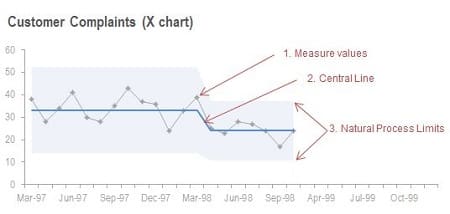Why do we set targets to begin with?
Targets are an element of proving whether we are achieving our strategy or not, and the purpose of measuring our strategy is to improve our organization’s performance, especially performance that we don’t currently have enough control over (and thus are in our strategy to begin with).
Targets represent the level of performance that we want to shift our measures (and the efforts of our teams) towards. In any environment, the best reason for setting targets is to inspire and motivate. Targets are not for highlighting our shortfalls or punishing teams for failing, despite what you might witness in common practice.
Why might we consider not setting targets during COVID?
With change all around us and outside forces driving that change, we might feel that it’s not worth trying to improve. We might think, what is the point of setting a target if we are just going to fail to hit it anyway? This is fear talking.
Remember, that even in non-COVID environments, when we set any target, we are “guesstimating”. No one ever knows the future and what will happen. Targets aren’t goal posts to hit or miss. Targets are intentions for improvement that will both push and pull us in the direction we most want or have to go. We want to move from a place of fear to a place of learning. We may not know the best way to respond yet, but we do know we need to respond and setting a target shares our intentions.
The answer is therefore YES! If COVID is driving change in our organizations, and we want to know how well we are changing in response to the new environment. This is the job of meaningful measures with targets.
When we set a target during COVID, should we set achievable or stretch targets?
Now that we understand the real reason for setting targets, is there a right answer to whether they should be achievable or stretch? Here’s what I have learned:
- It takes practice and confidence-building to achieve a strategic target, so you want to foster a psychologically safe place for your team to try and fail or win.
- To motivate teams, work with them to set the targets and set 2-3 targets for any single performance measure.
- The first target is shorter term and not that challenging to achieve; it’s for the purpose of building target-accomplishing momentum
- The interim target is an opportunity to build more capability and confidence in order to stretch.
- The last one is the stretch, which you might have no idea of how to reach at this point, but as you progress to the interim target, you can then decide and adjust along the way.
- You may never achieve a stretch target, and that is ok too.
- Celebrate any progress, whether it reaches target or not.
Is it only the number that matters when inspiring teams with targets?
Sometimes just talking numbers isn’t enough, especially when the world seems so strange and difficult. Try communicating with vivid and specific language to describe what the world feels or looks like after the target is accomplished. Lead with “Why” we need to change and how it will help us all in the future.
What bad habit might be standing in our way of sensible targets?
We need to overcome the insidious and common habit of comparing two points of data, such as this month compared to last month, or this month compared to same time last year. Otherwise, you will just be reacting to a variation roller coaster, and never really understanding what performance is doing. Good targets are about ongoing capability, not one-hit wonders. Instead use a control chart (also known as an XMR chart) so you can compare the mean line, which represents the current average level of performance, with the target (your future desired level of performance).

Want to read more about Targets?



